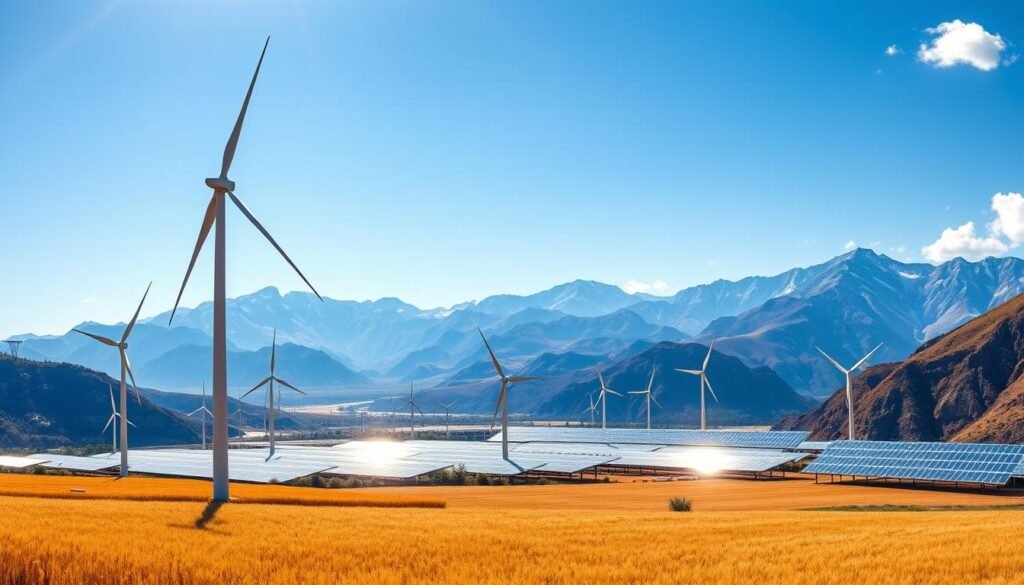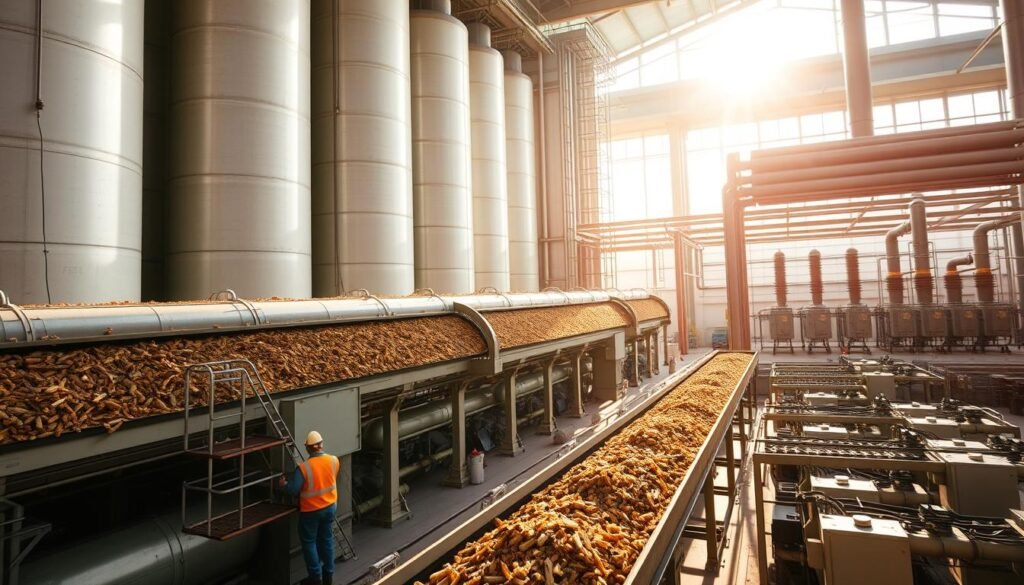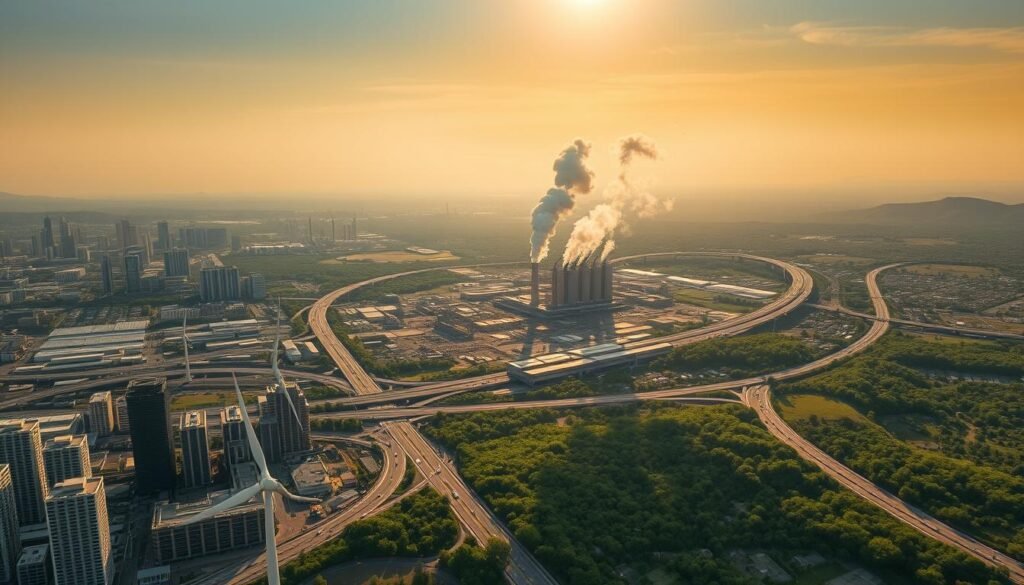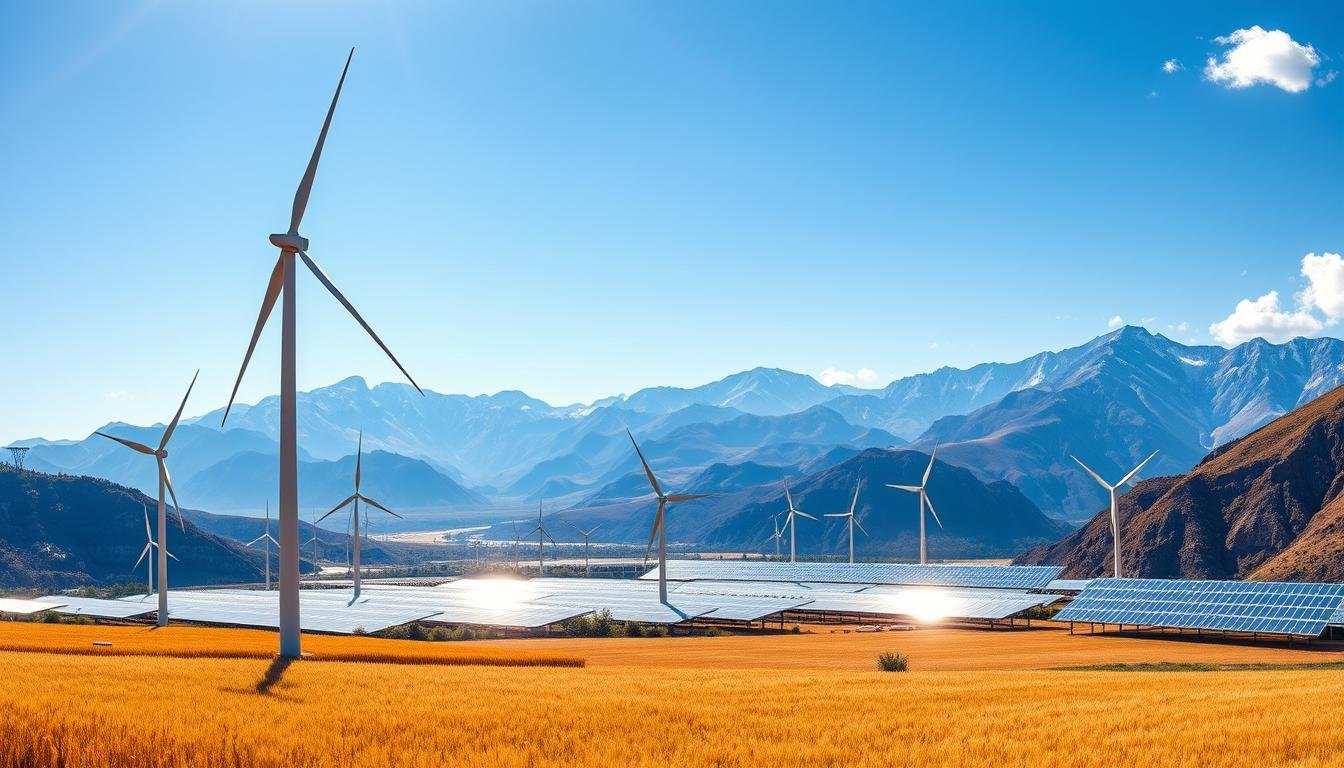The United States is moving towards renewable energy. It’s focusing on solar and wind power to cut down on greenhouse gas emissions. Many states are investing in clean energy to ensure a sustainable future.

The U.S. has big goals for renewable energy. It wants to use clean energy more to fight climate change. By using renewable energy, the country can lessen its dependence on fossil fuels.
Introduction to Renewable Energy
The renewable energy sector is growing fast. This is because people need sustainable energy solutions. The U.S. aims to lower its carbon footprint by using clean energy sources.
Key Takeaways
- The U.S. is transitioning to renewable energy sources to reduce greenhouse gas emissions.
- Sustainable energy is crucial for the country’s future, with a focus on clean energy solutions.
- Rapid growth in the renewable energy sector is driven by the need for sustainable energy solutions.
- The U.S. is committed to reducing its carbon footprint by transitioning to clean energy sources.
- Reneable energy, including solar and wind power, is playing a vital role in shaping the country’s energy landscape.
- The current state of renewable energy in the U.S. is promising, with many states investing in clean energy infrastructure.
The Current State of U.S. Renewable Energy Prospects
The United States has seen a big jump in the renewable energy market lately. This is thanks to falling costs and more people wanting clean energy. Looking at where renewable energy is headed is key to a greener future.
Recent numbers show renewables like solar and wind are getting more popular. This growth is set to keep going, thanks to good energy trends and support from clean energy companies. Big names like Tesla, Vestas, and Siemens Gamesa are leading the charge.
Market Share of Renewable Sources
Here’s a table showing the share of renewable energy in the U.S.:
| Energy Source | Market Share |
|---|---|
| Solar | 20% |
| Wind | 30% |
| Hydroelectric | 10% |
| Geothermal | 5% |
Growth Trends Since 2020
The renewable energy sector has grown a lot since 2020. Many states aim to use more renewable energy. This has brought in more money for clean energy companies, creating jobs and driving new ideas.
Solar Power: America’s Brightest Energy Future
Solar energy is becoming a big deal in the U.S. Many states are putting a lot of money into solar projects. The cost of solar energy has gone down a lot, making it cheaper than fossil fuels. This has led to more people and businesses using solar power to save on energy costs.
Using solar power has many benefits. It cuts down on greenhouse gas emissions and lowers energy bills. It also helps us be more independent from other energy sources. Plus, solar power can run electricity, heat water, and even power cars. As technology gets better, we’ll see even more cool ways to use solar energy.
Some key advantages of solar energy include:
- Renewable and sustainable
- Zero emissions or pollution
- Low maintenance costs
- Energy independence
As the U.S. moves towards renewable energy, solar power will be key. It’s cheap, good for the planet, and helps us use less fossil fuels. By choosing solar power, we’re making a better future for ourselves and future generations.
Wind Energy Revolution in American Communities
The United States is moving towards renewable energy, with wind energy leading the way. Wind energy is becoming more popular as states invest in it. This is because wind energy technology is getting cheaper and more people want clean energy.
Wind energy is a clean and sustainable option compared to fossil fuels. Community wind projects are key in this shift. They let local communities produce their own energy. These projects also create jobs and boost local economies.
- Job creation and local economic growth
- Reduced greenhouse gas emissions and environmental impact
- Increased energy independence and security
- Lower energy costs for local residents and businesses
As the wind energy movement grows, community projects will become even more important. With government support and private investment, these projects can help local communities thrive. They also contribute to a greener future for the United States.
Hydroelectric Power: Tapping Into Natural Resources
Hydroelectric power is key to the U.S.’s renewable energy mix. It’s clean and reliable, making it a top choice for green energy. By using water’s energy, hydroelectric plants produce electricity with little harm to the environment.
There are many good things about hydroelectric power. It’s packed with energy and costs less to run. Plus, it can last for decades with little upkeep. This makes it a smart choice for making electricity. It also helps cut down on harmful emissions and fight climate change.
Some of the key advantages of hydroelectric power include:
- Reliability: Hydroelectric power plants can operate continuously, providing a reliable source of electricity.
- Low operating costs: Hydroelectric power plants have low operating costs, making them a cost-effective option for electricity generation.
- Environmental benefits: Hydroelectric power is a clean source of energy, producing no greenhouse gas emissions or other pollutants.
As the U.S. moves towards a greener energy future, hydroelectric power will stay important. By focusing on hydroelectric and other natural resources, the U.S. can lessen its fossil fuel use. This will help create a more sustainable energy mix.
Geothermal Energy: Underground Potential
Geothermal energy is a promising source of renewable energy. Many western states have a lot of geothermal capacity. It uses the Earth’s core heat to make electricity, making it clean and sustainable.
This energy helps us use less fossil fuels and cut down on greenhouse gas emissions. It’s reliable, has low costs, and is good for the environment.
As emerging technologies get better, we’ll see more efficient ways to use geothermal energy. For example, enhanced geothermal systems (EGS) are being made to use hot rock formations. This could increase how much geothermal energy we can make.
There are investment chances in geothermal energy for companies and people who want to support renewable energy. With more demand for clean energy, geothermal energy will be key in our move to a greener future. Some states with a lot of geothermal potential are:
- California
- Nevada
- Utah
- Oregon
As we keep exploring and improving geothermal energy, we’ll see it grow a lot. It will help make our energy mix cleaner and more sustainable. Geothermal energy can also provide steady power, helping the grid and other renewable energy sources work better together.
Biomass and Waste-to-Energy Innovations
Biomass energy is a key player in the renewable energy field. It comes from various sources like wood, crops, and waste. These materials can be turned into energy through different methods. Waste-to-energy technologies are also gaining traction, with companies pouring money into them.
These innovations offer many benefits. They help cut down on waste, create energy, and fight climate change. The main advantages are:
- Reduced greenhouse gas emissions
- Less waste in landfills
- Clean energy production
Renewable energy innovations, like biomass and waste-to-energy, are vital for a greener future. As the U.S. keeps investing in these areas, we’ll see biomass and waste-to-energy grow a lot.

Grid Infrastructure and Energy Storage Solutions
The United States is moving towards renewable energy, and a strong grid is key. Energy storage is vital for using renewable energy sources. The grid is getting better to handle more renewable energy, thanks to smart technology.
Smart grid tech changes how we get and use energy. It lets us watch and control energy use in real time. This makes energy use more efficient and cuts down on waste. Solutions like batteries store extra energy from renewables, keeping the power steady.
Advances in Energy Storage
Better batteries are important for using more renewable energy. Companies like Tesla and LG Chem are working hard on battery tech. This makes it cheaper and more efficient. The grid is also getting better to handle more renewable energy, with smart tech and storage solutions leading the way.
Distribution Networks
The grid is getting better to handle more renewable energy. Microgrids are being built. They are small energy systems that can work on their own. Microgrids help remote areas and support renewable energy projects.
- Smart grid technology
- Battery storage advances
- Distribution networks
In summary, grid and storage solutions are key for renewable energy. With smart tech, better batteries, and upgraded grids, the US is moving towards a greener, more reliable energy system.
Economic Benefits of Renewable Energy Transition
The move to renewable energy is changing the U.S. economy. One big plus is the creation of clean energy jobs. As we use more renewable energy, we need more skilled workers. This leads to new jobs in solar and wind maintenance.
Some key benefits of switching to renewable energy include:
- Boosting local economies with renewable energy investments
- Lowering energy costs for homes and businesses
- Creating new jobs in clean energy
The shift to renewable energy does more than just create jobs and save money. It also drives innovation and investment in new tech. This boosts economic growth and development.
As we keep moving towards renewable energy, we’ll see more benefits. We’ll see more investment in clean energy and the start of new industries and jobs.
The renewable energy shift is good for the planet and the economy. Moving away from fossil fuels and towards cleaner energy will bring more benefits. We’ll see more jobs and economic growth in local areas.
Environmental Impact and Sustainability Goals
Switching to renewable energy is key to lessening our environmental footprint. As we move towards cleaner energy, setting clear sustainability goals and carbon reduction targets is vital. Renewable energy sources have a much lower environmental impact than fossil fuels. This makes them a great choice for powering our homes, businesses, and industries.
Companies and countries are setting big goals to cut down on greenhouse gas emissions. They aim to reduce these emissions by 50-80% by 2050. To meet these goals, they’re taking steps to protect ecosystems from the effects of renewable energy projects. Some of these steps include:
- Checking the environmental impact of renewable energy projects before they start
- Protecting wildlife and ecosystems during construction
- Monitoring and lessening the environmental impact of projects while they’re running

Companies and countries are also setting sustainability goals, with many aiming to be carbon neutral by 2050. These goals are pushing innovation in renewable energy. New technologies and practices are being developed to make energy production cleaner. By focusing on sustainability and reducing carbon, we can make the world a better place for our children and grandchildren.
Policy Framework and Government Initiatives
The move to renewable energy gets a big boost from a strong policy framework and government initiatives. These efforts aim to grow renewable energy use. They help cut down on fossil fuel use and fight climate change.
One major part of this plan is offering federal tax incentives. These incentives help both companies and individuals who invest in renewable energy. They include tax breaks for solar and wind projects, and grants for new green tech research.
Supporting Renewable Energy Growth
States also play a big role with their own state-level programs. These programs help renewable energy grow. They include rules for using more renewable energy, laws for net metering, and tax breaks for green projects.
International Cooperation
The U.S. is part of several international agreements too. These agreements help lower greenhouse gas emissions and boost renewable energy. The Paris Agreement and the Clean Energy Ministerial are examples. They bring countries together to share knowledge and work on climate change.
Investment and Job Creation in Clean Energy
The clean energy industry is growing fast. Many companies are investing in renewable energy. This growth has created lots of job creation opportunities. More and more people are working in clean energy.
As demand for renewable energy goes up, more companies want to invest. This makes clean energy investment very appealing.
Some key areas for job creation in clean energy are:
- Solar panel installation and maintenance
- Wind turbine manufacturing and maintenance
- Energy efficiency consulting and auditing
These jobs help the clean energy industry grow. They also offer stable and rewarding careers. The renewable energy jobs market is expected to keep growing.
As the clean energy industry grows, we’ll see new technologies and jobs. With the right clean energy investment and support, the U.S. can lead in a sustainable energy future. This will create thousands of new renewable energy jobs.
Conclusion: Powering America’s Sustainable Future
The shift to renewable energy is key for America’s green future. It cuts down on harmful emissions and fights climate change. It also brings in clean energy jobs and boosts local economies.
Businesses, investors, and leaders see the big chance in solar, wind, hydro, and geothermal power. They know it’s a game-changer.
With smart government plans, strong investments, and new ideas, the U.S. is ready to lead in renewable energy. We can meet our big sustainability goals and make a better future for all.
The renewable energy movement is starting, and we know where we’re going. By moving forward, we can make America’s future green, reduce harm to our planet, and open up new jobs in clean energy. It’s time to take action and work together for a better tomorrow.
FAQ
What is the current state of renewable energy in the U.S.?
Renewable energy in the U.S. is booming, with solar and wind leading. Many states aim to use more renewable energy.
What are the benefits of solar power in the U.S.?
Solar power is growing fast in the U.S. Its cost has dropped a lot, making it competitive with fossil fuels. It’s key to moving to renewable energy.
What is the wind energy revolution in American communities?
Wind energy is getting stronger, with states investing in it. Offshore and land-based wind farms, and community projects are popping up everywhere.
What is the potential of geothermal energy in the U.S.?
Geothermal energy is promising, especially in western states. New tech like enhanced geothermal systems (EGS) is being developed. There are chances for companies and individuals to invest.
What are the economic benefits of the renewable energy transition?
The shift to renewable energy is creating many jobs. From solar installers to wind techs, it’s boosting local economies and lowering energy costs.
What is the environmental impact of the renewable energy transition?
Switching to renewable energy helps cut greenhouse gas emissions and fight climate change. Many countries and companies are setting targets and goals to support this.
What government initiatives are supporting the renewable energy transition?
Governments are key in the renewable energy shift. They offer incentives and subsidies to help develop renewable energy. Tax incentives, state programs, and global agreements are all helping the industry grow.
What are the investment and job creation opportunities in clean energy?
The clean energy sector is expanding fast, with companies investing in infrastructure. It’s creating new jobs and offering big investment chances. Many are looking to get into renewable energy projects.
